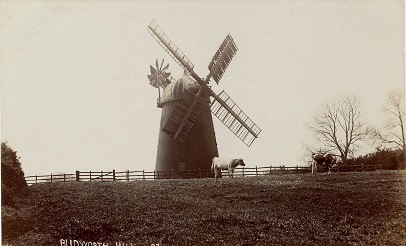



 |
 |
 |
 |
 |
 |
 |
 |
 |
 |
 |
 |
 |
 |
 |
 |
 |
 |
 |
 |
 |
 |
 |
 |
 |
 |
 |
 |
 |
 |
 |
 |
 |
The Blidworth Windmill as it was in 1905
 The Windmill has been a Blidworth land mark for many years, and was a working windmill
between 1816 and 1920 producing flour for the villagers thus enabling them to
make their own bread. Since that time it has sadly fell into disrepair.
Standing
at the highest point of the village, the windmill site is a unique vantage point
from where it is possible to view other landmarks in neighbouring counties
including Lincoln Cathedral and Belvoir Castle. The site is also conveniently
situated close to a number of walking routes through the County.
The Windmill has been a Blidworth land mark for many years, and was a working windmill
between 1816 and 1920 producing flour for the villagers thus enabling them to
make their own bread. Since that time it has sadly fell into disrepair.
Standing
at the highest point of the village, the windmill site is a unique vantage point
from where it is possible to view other landmarks in neighbouring counties
including Lincoln Cathedral and Belvoir Castle. The site is also conveniently
situated close to a number of walking routes through the County.
At
the beginning of 2013 a group of interested people met together to discuss how
it might be possible to enable visits to the Blidworth Windmill to become available
to the community as A Local Heritage Site and to this end the group decided to
become known as “The Friends of Blidworth Windmill”
Blidworth
Parish Council expressed support for the project and agreed to a meeting with the
Senior Heritage Officer, of Notts C.C. and Barker & Langham, Consultants.
In
the meantime, discussions took place with Notts C.C. and the Consultants who
have suggested that 'The Friends of Blidworth Windmill’ make an application directly
to The Lottery Heritage fund by first submitting a ‘Project Enquiry Form’ A
draft of this was prepared with the help of both the above.
A
more comprehensive report was produced by Barker & Langham,
Consultants, which included the survey report produced by Soul Architects
and some project costs.
The
Nottinghamshire Buildings Preservation Trust, who supplied the funding for
the report on the windmill requested photographs of other local
historical items of interest and also details of local groups who would support
the project.
Ravenshead
Church of England Primary School in Ravenshead was approached and a positive response was received. Other local Schools need to be contacted
to get them involved together with
groups such as Women’s Fellowship, Scouts, Cubs, Rotary, WI
etc.
More
recently a group of up to 50 people, the majority of which consisted of pupils
parents and staff of the Blidworth Oaks Primary School requested that a visit
to the Windmill should be included in a family ramble around the village. Our
Society was represented on the ramble and the group spent time inside the windmill
where we had lunch and discussed plans for its future and benefits for the
village. Everyone agreed that it was an educational and enjoyable experience,
and the input and knowledge of our Society was much appreciated.
Lindley's Mill Sutton in Ashfield
 Lindley's Mill at Prospect Place in Sutton in Ashfield is a rare example of a stone built tower mill. In the past the tower has been painted on the outside with tar to ensure that it was water proof, an essential requirement for a flour mill. The remains of this paint work are still evident. Lindley's mill became a grade II listed building on September 26th 1974.
Lindley's Mill at Prospect Place in Sutton in Ashfield is a rare example of a stone built tower mill. In the past the tower has been painted on the outside with tar to ensure that it was water proof, an essential requirement for a flour mill. The remains of this paint work are still evident. Lindley's mill became a grade II listed building on September 26th 1974.
The tower mill that we see today was built in 1820 and replaced a "wooden post mill" that stood on Mill Street on the opposite side of High Pavement.
The houses on the west side of Prospect Place were built at the turn of the 19th/20th century. The mill would have become inoperable due to the proximity of the houses, because there would have been insufficient space for the sails to turn. The length of the sails being approximately 35 feet and would have almost touched the ground.









